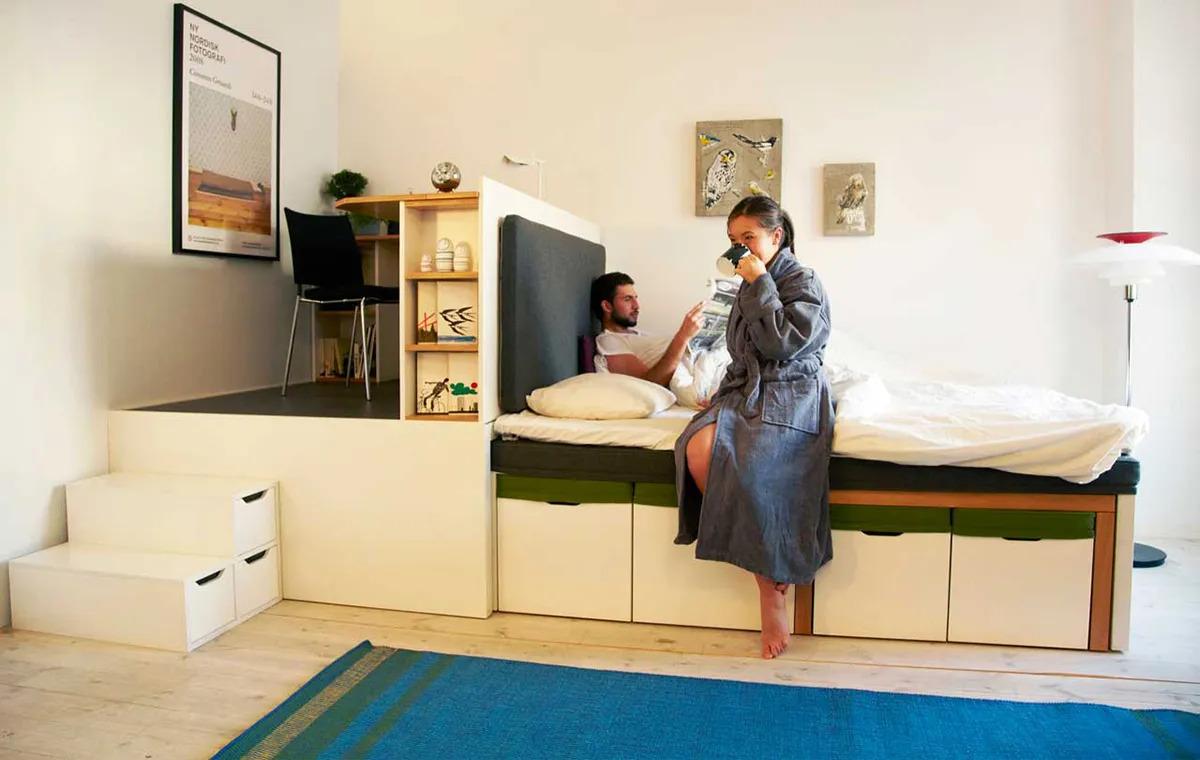
Fri Mar 22 - Written by: Ruth
7 Stunning Examples of Sustainable Minimalism in Home Design
Explore beautiful examples of sustainable minimalism in home design that combine eco-friendly practices with clean, modern aesthetics. Learn how to create a stylish and environmentally conscious living space.
Looking to create a beautiful home that’s good for the planet? Sustainable minimalism might be your perfect match. This design approach combines eco-friendly materials with clean lines and clutter-free spaces to create homes that are both stunning and environmentally responsible.
You’ll be amazed at how simple changes can transform your living space into an earth-conscious sanctuary. From reclaimed wood features to smart energy solutions these seven homes show that less really can be more. They prove you don’t need to choose between style and sustainability – you can have both while making a positive impact on the environment.
1. Embracing Natural Light With Floor-To-Ceiling Windows
 Floor-to-ceiling windows flood this minimalist living room with natural light, accentuating clean lines and reducing the need for artificial lighting. Source: Fancy House Design
Floor-to-ceiling windows flood this minimalist living room with natural light, accentuating clean lines and reducing the need for artificial lighting. Source: Fancy House Design
Floor-to-ceiling windows serve as a cornerstone of sustainable minimalist design by maximizing natural light and reducing energy consumption.
Energy-Efficient Glass Solutions
Modern floor-to-ceiling windows feature advanced glass technologies that transform your home’s energy profile. Low-E glass coatings reflect heat while letting natural light flood your spaces reducing the need for artificial lighting by up to 75%.
Triple-pane windows with argon gas filling provide superior insulation maintaining indoor temperatures year-round. Smart glass options like electrochromic windows automatically adjust their tint based on sunlight intensity cutting cooling costs by 20%. These energy-efficient solutions don’t just lower your carbon footprint—they create a seamless connection with the outdoors while protecting your furniture from UV damage.
Minimalist Window Treatments
You’ll want to keep window treatments simple to maintain the clean aesthetic of floor-to-ceiling windows while enhancing their sustainable benefits. Solar shades made from recycled materials offer UV protection without blocking views or natural light.
Automated bamboo blinds provide privacy while adding natural texture to your space. Remote-controlled cellular shades trap air in honeycomb-shaped pockets creating an extra layer of insulation. These minimalist options complement the windows’ sleek design while helping regulate indoor temperature reducing your reliance on heating and cooling systems by up to 30%.
2. Incorporating Recycled Materials in Modern Ways
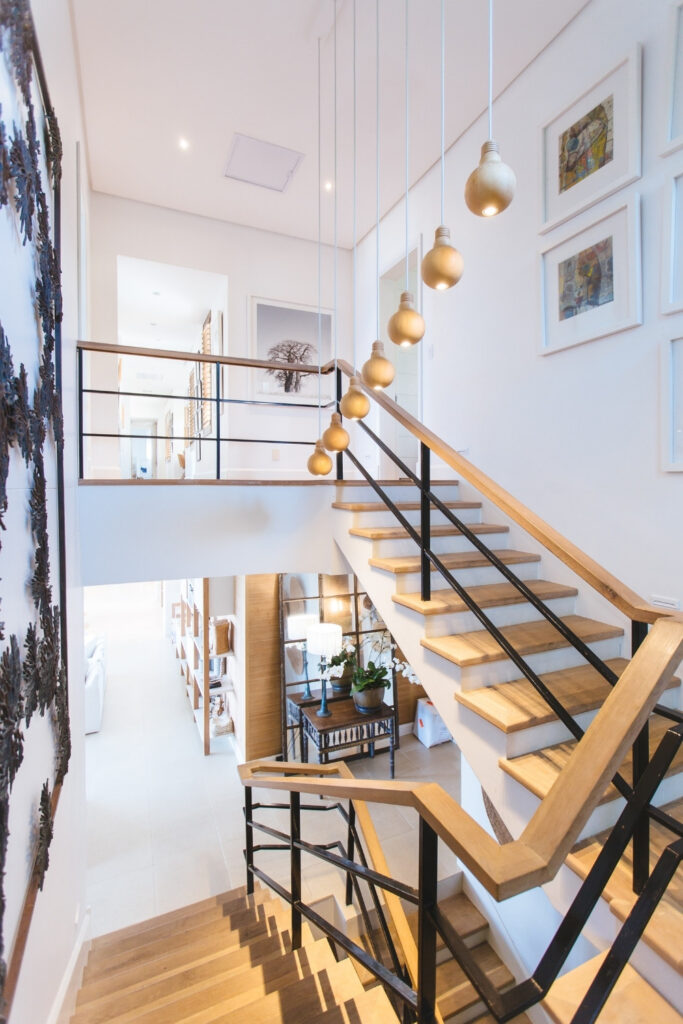 This kitchen showcases how recycled and sustainable materials can create a modern, minimalist aesthetic with reclaimed wood features and eco-friendly surfaces. Source: Sustainable Jungle
This kitchen showcases how recycled and sustainable materials can create a modern, minimalist aesthetic with reclaimed wood features and eco-friendly surfaces. Source: Sustainable Jungle
Transform your living space with innovative applications of recycled materials that blend seamlessly with contemporary design aesthetics.
Repurposed Wood Features
Breathe new life into your home with reclaimed wood that tells a unique story. Old barn beams can become striking exposed ceiling features while weathered floor planks create character-rich accent walls. You’ll find salvaged wood working beautifully for built-in shelving units custom storage solutions & floating furniture pieces.
Consider incorporating wood from local demolition projects into kitchen islands or bathroom vanities for an eco-conscious statement piece. These elements not only reduce environmental impact but also add warmth & authenticity to minimalist spaces.
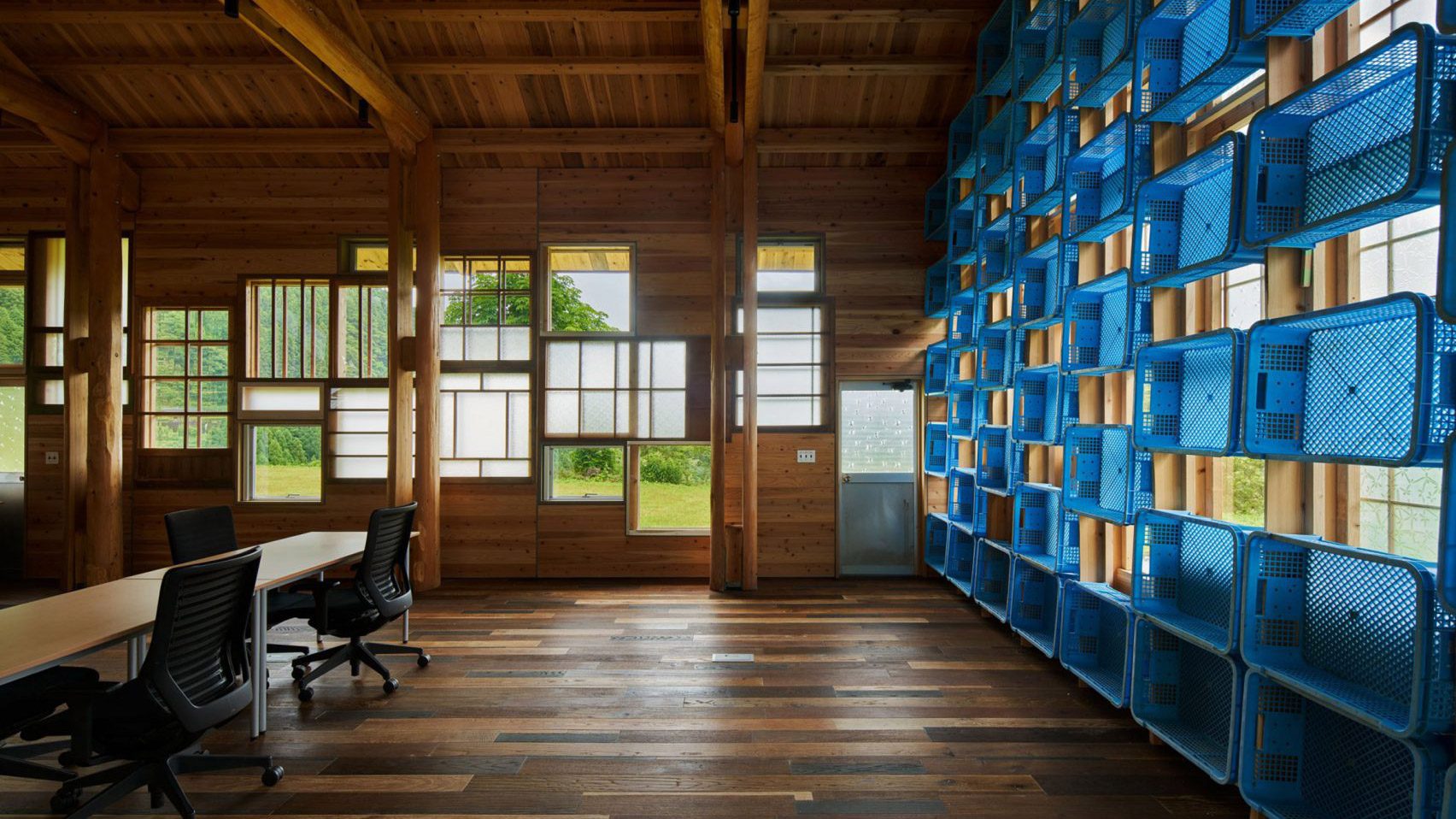 Kamikatsu Zero Waste Center exemplifies sustainable design using reclaimed materials with a modern aesthetic. Source: Dezeen
Kamikatsu Zero Waste Center exemplifies sustainable design using reclaimed materials with a modern aesthetic. Source: Dezeen
Sustainable Metal Accents
Give industrial materials a second chance with creative metal applications throughout your home. Repurposed copper pipes make stunning open shelving systems while salvaged steel can transform into sleek stair railings or room dividers.
You’ll love how recycled aluminum panels create modern wall features or how old metal drums become eye-catching pendant lights. Try incorporating recycled brass or copper fixtures in bathrooms & kitchens for an elegant touch that’s environmentally responsible. These metal elements add industrial chic to minimalist spaces while keeping materials out of landfills.
3. Maximizing Space With Multi-Functional Furniture
 Modular furniture design that transforms between different functions, maximizing space in small living areas. Source: Illustrarch
Modular furniture design that transforms between different functions, maximizing space in small living areas. Source: Illustrarch
Smart furniture choices play a crucial role in sustainable minimalist design by reducing the need for excess pieces and maximizing your living space’s functionality.
Built-In Storage Solutions
Built-in storage seamlessly integrates with your walls and corners to eliminate clutter while preserving your home’s minimalist aesthetic. Custom floor-to-ceiling cabinets in natural materials like bamboo or reclaimed wood create sleek storage solutions that don’t compromise your sustainable values. Hidden drawers under stairs optimize unused spaces while maintaining clean lines. Pull-out pantries slim enough to fit between appliances make use of narrow gaps in your kitchen. These clever storage solutions often incorporate soft-close mechanisms and handle-free designs that maintain the smooth visual flow of your space while reducing the need for additional furniture pieces.
Transformable Living Spaces
Your furniture should work twice as hard in a sustainable minimalist home. Consider wall beds that fold away to reveal home office setups or expandable dining tables that adjust from intimate two-person meals to dinner party mode. Modular sofas with moveable sections adapt to your changing needs while minimizing furniture waste.
 This adaptable living space features furniture that serves multiple purposes, reducing the need for excess pieces. Source: Adorno Design
This adaptable living space features furniture that serves multiple purposes, reducing the need for excess pieces. Source: Adorno Design
Look for coffee tables with lift-top surfaces that transform into work stations complete with hidden storage compartments. These versatile pieces often feature eco-friendly materials like FSC-certified wood or recycled metal components. By choosing furniture that serves multiple purposes you’ll need fewer pieces overall reducing both your environmental impact and spatial footprint.
4. Creating Harmony With Earth-Toned Color Palettes
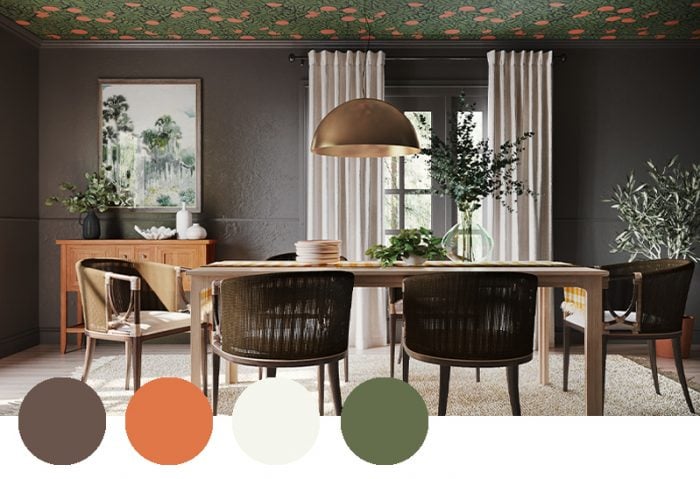 This living space demonstrates how earth tones create a calming atmosphere while complementing sustainable design materials. Source: Havenly
This living space demonstrates how earth tones create a calming atmosphere while complementing sustainable design materials. Source: Havenly
Earth-toned colors create a calming atmosphere while reflecting sustainable design principles in minimalist homes. These natural hues connect indoor spaces with the environment seamlessly.
Natural Paint Selections
Choose VOC-free paints in warm browns terra cottas & soft greiges to bring nature inside. Many eco-friendly paint brands like Clare Paint & ECOS Paints offer organic pigments derived from clay minerals & plant materials. These natural options provide excellent coverage while improving indoor air quality with zero toxic emissions.
For accent walls try textured finishes using lime wash or clay-based paints that add subtle depth. Popular earth tones include warm sandstone desert sage & rich umber which create a grounded feeling in any room. These paints are both durable & biodegradable making them perfect for sustainable minimalist spaces.
Sustainable Textile Choices
Opt for organic cotton hemp & linen fabrics in muted earth tones to complement your natural color scheme. Look for GOTS-certified textiles that use eco-friendly dyes from plants & minerals. Consider throws pillows & curtains in shades like olive moss & clay that add texture without overwhelming the space.
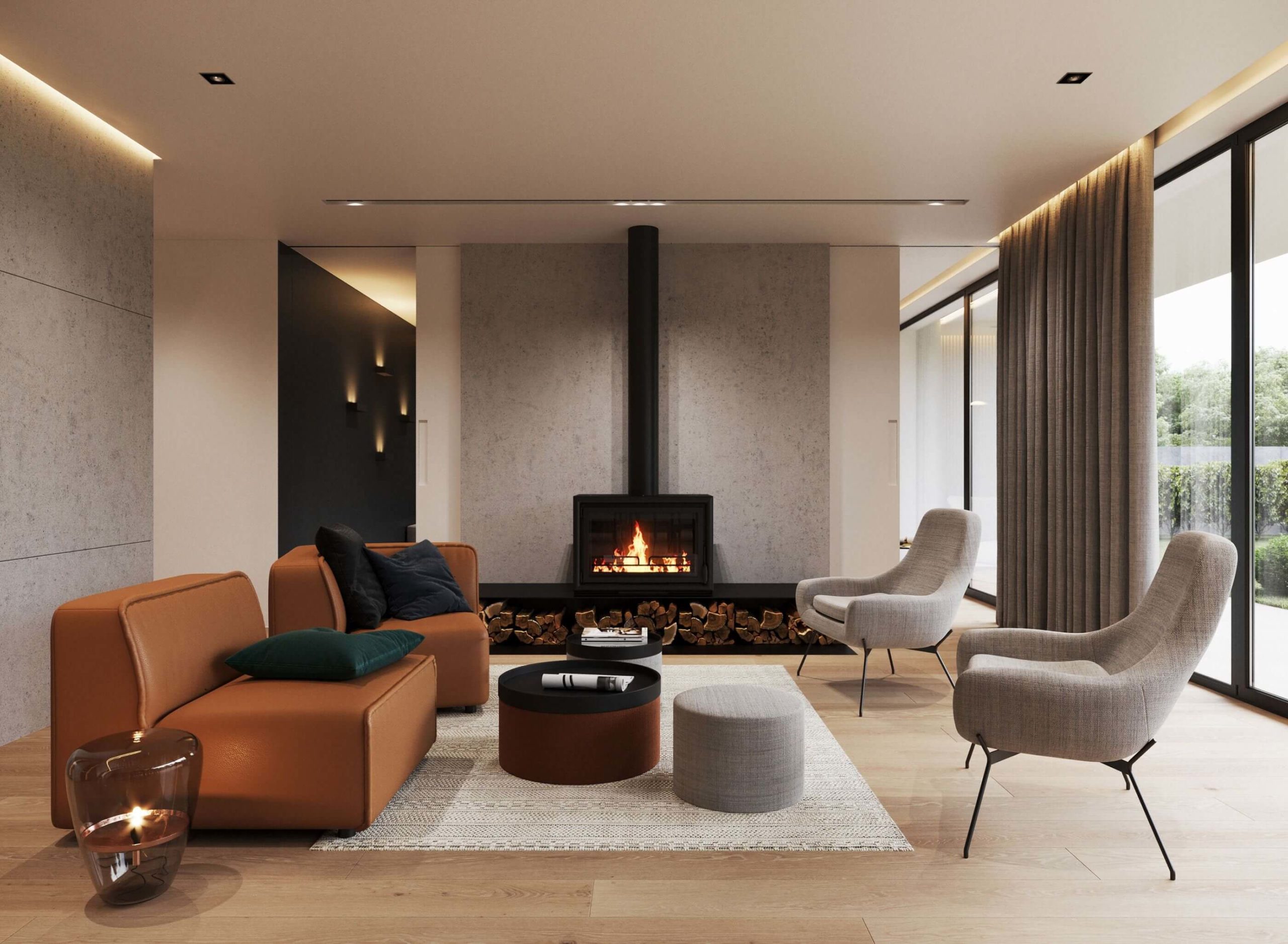 Natural textiles in earth tones create visual warmth while maintaining a minimalist aesthetic with sustainable materials. Source: Hommés Studio
Natural textiles in earth tones create visual warmth while maintaining a minimalist aesthetic with sustainable materials. Source: Hommés Studio
Jute & sisal rugs in natural beige tones ground your rooms while providing sustainable floor coverage. Choose upholstery fabrics made from recycled materials like PET bottles in coordinating earth hues. These textiles aren’t just environmentally friendly – they’re also more durable & easier to maintain than conventional options.
5. Designing Smart Storage Solutions With Reclaimed Materials
Transform your living space with innovative storage solutions that blend sustainability with style. Here’s how to maximize organization while minimizing environmental impact.
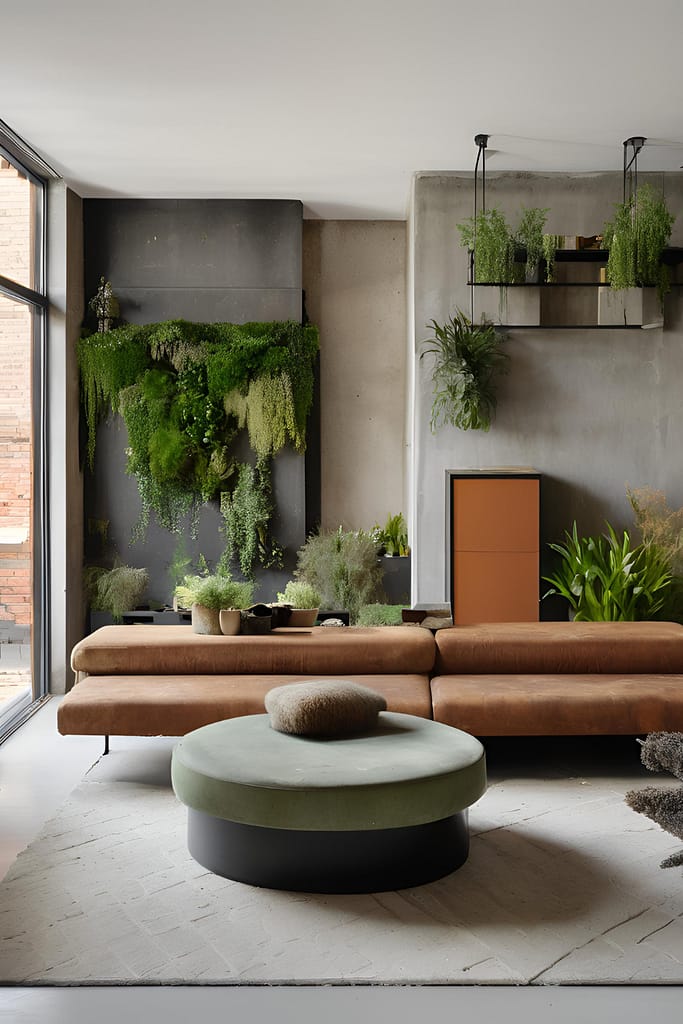 Elegant minimalist storage solution crafted from sustainable bamboo, combining functionality with eco-friendly design. Source: SampleBoard
Elegant minimalist storage solution crafted from sustainable bamboo, combining functionality with eco-friendly design. Source: SampleBoard
Hidden Organization Systems
Create seamless storage with reclaimed barn wood sliding panels that conceal built-in shelving units. You’ll find clever hideaway spots behind repurposed factory doors or vintage shutters that slide smoothly on salvaged railroad tracks.
Install pull-out drawers made from old shipping crates under staircases to maximize unused space. Consider flip-down desks crafted from vintage gymnasium flooring that tuck away when not in use. These hidden systems keep your space clutter-free while giving materials a second life.
Eco-Friendly Cabinet Solutions
Transform old wooden pallets into modular wall cabinets that showcase both form and function. You’ll love how wine crates become unique open shelving units perfect for displaying everyday items. Install kitchen cabinets made from salvaged wood doors complete with their original hardware and character-rich patina.
 Creative storage solutions using recycled and reclaimed materials that blend functionality with sustainable design principles. Source: Paper Mart Blog
Creative storage solutions using recycled and reclaimed materials that blend functionality with sustainable design principles. Source: Paper Mart Blog
Add pull-out pantry systems crafted from reclaimed scaffolding boards that maximize vertical storage space. These solutions combine practical storage with sustainable materials while adding distinctive character to your minimalist design.
6. Integrating Indoor-Outdoor Living Spaces
Sustainable minimalism shines brightest when it erases the boundaries between interior and exterior spaces. These seamless transitions create a natural flow while maximizing your home’s connection to the environment.
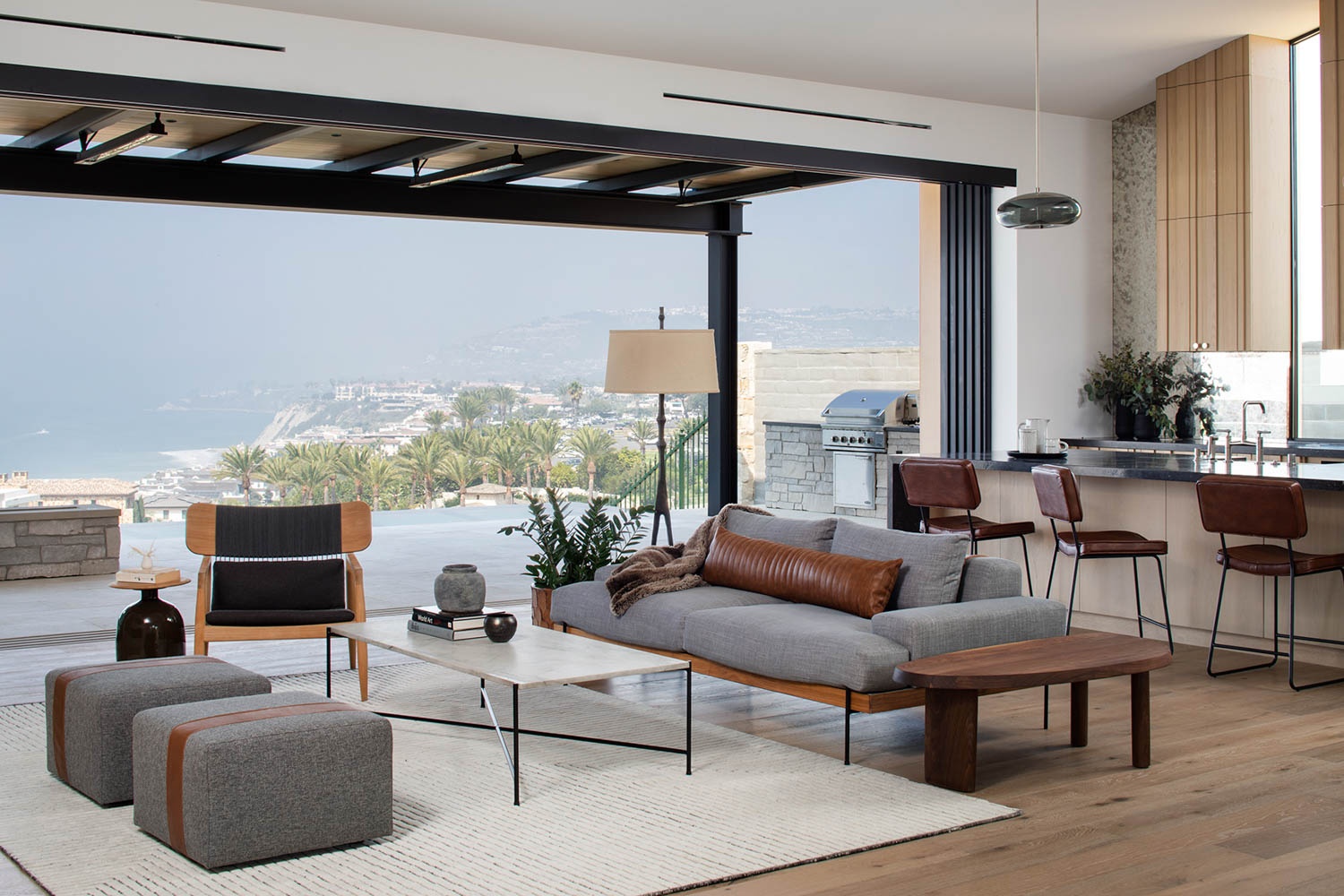 Seamless transition between indoor and outdoor living spaces with minimalist design elements and natural materials. Source: Interior Design Magazine
Seamless transition between indoor and outdoor living spaces with minimalist design elements and natural materials. Source: Interior Design Magazine
Living Walls and Vertical Gardens
Transform your minimalist space with stunning living walls that double as natural air purifiers. These self-sustaining vertical gardens feature drought-resistant plants like succulents ferns and air plants arranged in modular panels made from recycled materials. You’ll love how these green installations create striking focal points while requiring minimal maintenance through smart irrigation systems.
The best part? They’ll improve your indoor air quality by filtering pollutants and releasing fresh oxygen. Choose native species to support local biodiversity and opt for hydroponic systems that use 90% less water than traditional gardening methods.
Minimalist Patio Designs
Create a sleek outdoor living space with clean lines and sustainable materials that mirror your interior aesthetic. Start with permeable pavers or recycled composite decking to minimize environmental impact. Add multifunctional furniture pieces like bamboo storage benches or FSC-certified wooden loungers that serve both practical and aesthetic purposes.
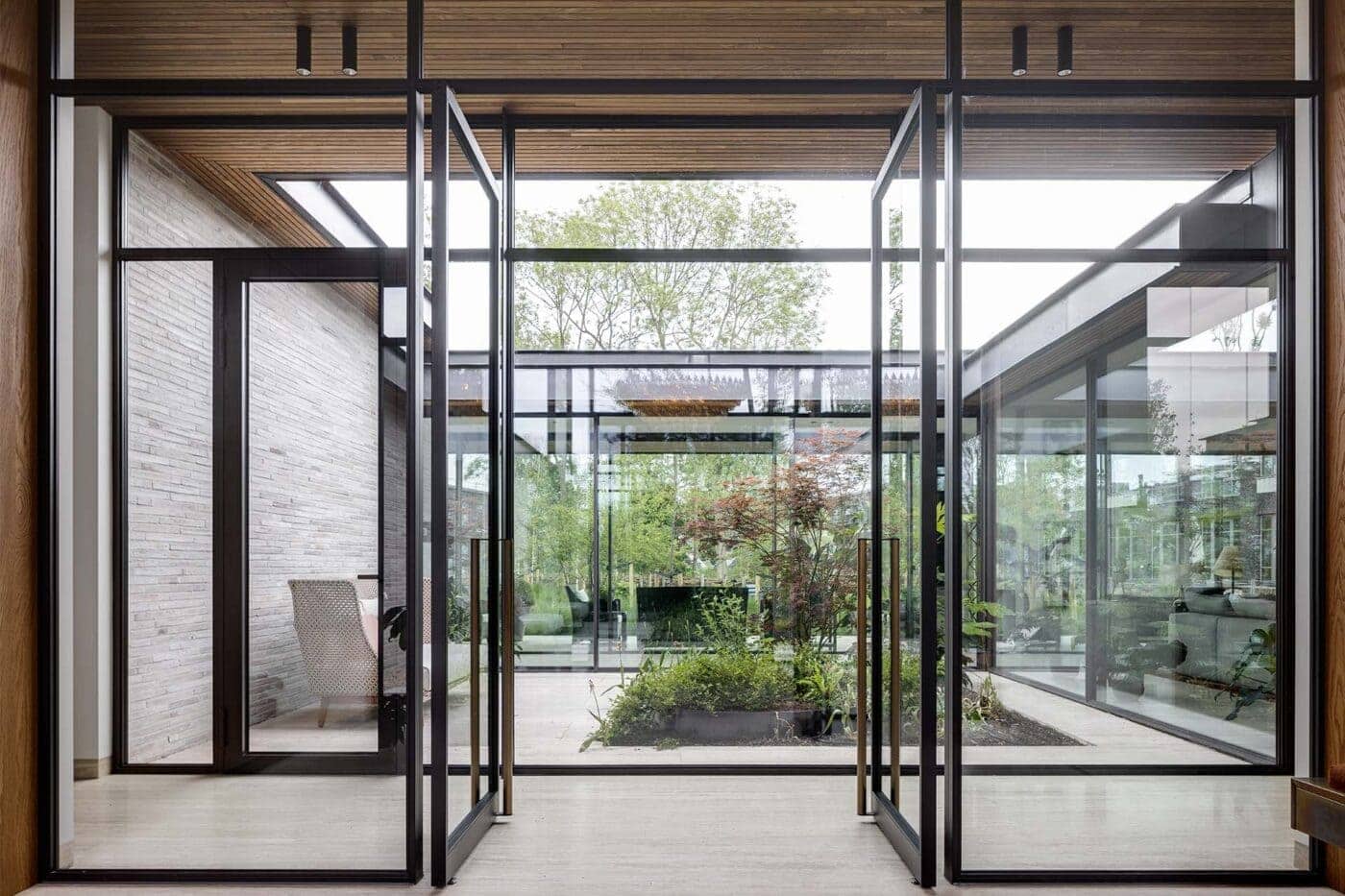 Modern patio design featuring sustainable wood elements that create a seamless extension of interior living spaces. Source: Thermory
Modern patio design featuring sustainable wood elements that create a seamless extension of interior living spaces. Source: Thermory
Your patio’s beauty will shine through carefully selected native plants in simple concrete planters. Consider retractable awnings made from recycled fabrics for shade control and a collapsible dining set that saves space when not in use. Solar-powered LED string lights provide eco-friendly illumination while maintaining the minimalist vibe.
7. Implementing Energy-Efficient Smart Home Features
Smart technology plays a crucial role in sustainable minimalist homes by optimizing resource usage and reducing energy waste through intelligent automation.
 Smart home technology integrated into minimalist design, optimizing energy efficiency through automated systems. Source: Illustrarch
Smart home technology integrated into minimalist design, optimizing energy efficiency through automated systems. Source: Illustrarch
Automated Climate Control
You’ll love how automated climate control systems transform your home into an energy-efficient sanctuary. These smart systems use AI-powered thermostats like Nest or Ecobee to learn your temperature preferences and daily routines. They’ll automatically adjust heating and cooling based on occupancy motion sensors real-time weather data and your schedule.
The real magic happens when you connect smart blinds and ventilation systems to work together. Your blinds will lower during peak sun hours to reduce cooling needs while automated vents redistribute air to maintain optimal temperatures. This integrated approach can cut your energy bills by up to 23% according to the Department of Energy.
Sustainable Lighting Systems
Smart lighting solutions take sustainable minimalism to the next level with sleek LED fixtures and intuitive controls. Motion sensors automatically switch lights off in empty rooms while daylight harvesting systems adjust artificial lighting based on natural light levels. You’ll find these features especially useful in spaces like hallways and bathrooms.
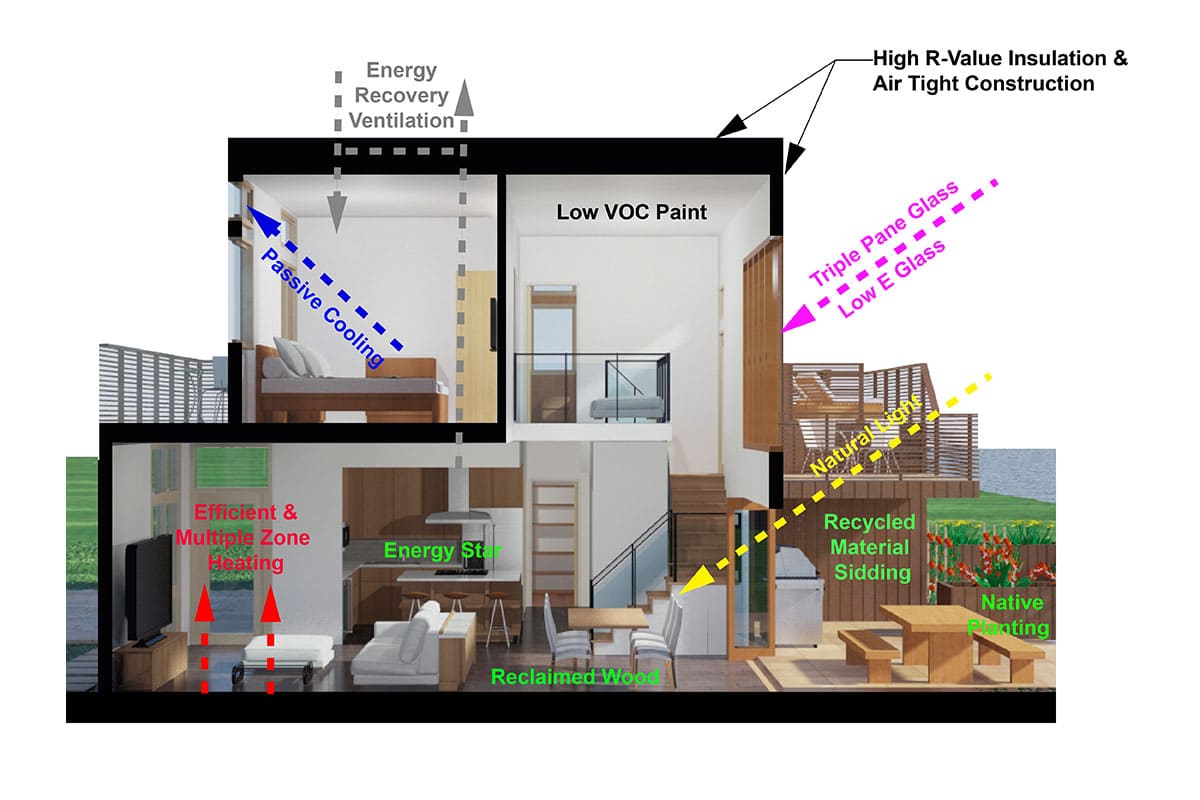 Modern sustainable home featuring energy-efficient design elements including solar panels and smart systems. Source: Fontan Architecture
Modern sustainable home featuring energy-efficient design elements including solar panels and smart systems. Source: Fontan Architecture
Install programmable LED strips under cabinets and along corridors for subtle ambient lighting that uses 75% less energy than traditional bulbs. Connect them to your smartphone to create automated schedules or adjust brightness with voice commands. Many systems also offer occupancy-based lighting zones so you’re only using energy where and when you need it.
How to Achieve Sustainable Minimalism in Your Home
- Start with a Clean Slate
Clear out unnecessary items using the one-in-one-out rule. Donate usable items to reduce waste. This creates a fresh foundation for your sustainable minimalist journey.
- Choose Natural Materials
Pick bamboo furniture renewable cork flooring or reclaimed wood pieces. These eco-friendly materials add warmth while reducing environmental impact.
- Maximize Natural Light
Install energy-efficient windows with proper insulation. Use light-colored organic fabrics for window treatments to reduce electricity usage during daytime hours.
- Invest in Quality
Buy fewer but better-quality pieces that last longer. Focus on timeless designs made from sustainable materials to minimize future replacements.
- Create Smart Storage
Use built-in solutions made from eco-materials. Install multifunctional furniture pieces that save space while reducing clutter.
- Add Living Elements
Include low-maintenance plants to purify air naturally. Choose native species that require minimal water and care.
- Carry out Energy Solutions
Install smart thermostats and LED lighting systems. Use automated controls to optimize energy consumption throughout your home.